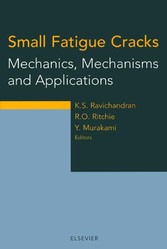Search and Find
Service
More of the content

Small Fatigue Cracks: Mechanics, Mechanisms and Applications - Mechanics, Mechanisms and Applications
Front Cover
1
Small Fatigue Cracks: Mechanics, Mechanisms and Applications
4
Copyright Page
5
CONTENTS
10
Preface
6
Referees
8
PART I: NUCLEATION OF SMALL CRACKS AND STAGE I GROWTH
14
Chapter 1. A Theory of Fracture with a Polygonal Shape Crack
16
Chapter 2. Fatigue Crack Nucleation in Metallic Materials
30
Chapter 3. Micromechanical Simulations of Stage I Fatigue Crack Growth under Multiaxial Loading
42
Chapter 4. Subsurface Fatigue-Crack Initiation and Growth of Plasma-Assisted Duplex Surface-Treated Tool Steel
52
Chapter 5. Effect of Graphite Nodule Distribution on Crack Initiation and Early Growth in Austempered Ductile Iron
62
PART II: THEORY OF SMALL CRACKS
70
Chapter 6. Mechanics of Small Fatigue Crack Propagation
72
Chapter 7. Analysis of Small Crack Growth Behavior using Unified Approach
86
Chapter 8. The Role of Grain-Induced Local Anisotropy on Stress Intensity Factor for Microstructurally-Small Cracks
98
PART III: SMALL CRACK GROWTH IN STRUCTURAL ALLOYS
106
Chapter 9. Significance of Crack Shape or Aspect Ratio to the Behavior of Small Fatigue Cracks in Titanium Alloys
108
Chapter 10. Fatigue Crack Tip Constraint and Closure as a Function of Crack Length
122
Chapter 11. Cause of Unsuccessful Results of Miner's Rule: Behavior of Small Fatigue Crack Growth under Repeated Two Step Loadings
132
Chapter 12. The Role of Near-Threshold Small-Crack Behavior in Life Prediction of Titanium Alloys For Use in Advanced Turbine Engines
144
Chapter 13. Growth of Small Fatigue Cracks in the Presence of Residual Stresses
156
Chapter 14. A Study of Small Fatigue Crack Growth in Cast Aluminum and Prediction of Fatigue Properties
168
Chapter 15. Influence of Environment on Small Fatigue Crack Growth
180
Chapter 16. Microstructural Influences on Fatigue Crack Growth in the Near Alpha Titanium Alloy TIMETAL 834
192
Chapter 17. Mechanisms of Fatigue Crack Nucleation of Surface and Subsurface Regions and Their Effect on Fatigue Life of Ti-10V-2Fe-3Al
200
Chapter 18. Crystallographic Orientation and Short Fatigue Crack Propagation in a Titanium Alloy
212
Chapter 19. Behavior of a Small Surface Crack in Prestrained Heat-Treated Carbon Steels
220
Chapter 20. Initiation and Propagation Behavior of Small Fatigue Cracks in HIP-Treated Aluminum Alloy: AC4CH
228
Chapter 21. Initiation and Growth Behavior of a Small Fatigue Crack in Nickel-Base Superalloy at Elevated Temperatures
236
PART IV: SMALL CRACKS IN ADVANCED MATERIALS
244
Chapter 22. The Importance of Small Fatigue Cracks in Advanced Materials
246
Chapter 23. Cyclic-Fatigue Crack Initiation and Propagation in Ceramics
260
Chapter 24. Small-Crack Behavior in Silicon Nitride at Elevated Temperature
272
Chapter 25. Subcritical Growth of Microstructurally Small Cracks in Silicon Nitride Ceramics
284
Chapter 26. Small Crack Effects in Ceramic Materials
296
Chapter 27. Initiation and Growth Mechanism of Small Fatigue Cracks in SiC/Al Composites
302
Chapter 28. Small Fatigue Cracks in Laminates with Through-Thickness Reinforcement
314
Chapter 29. Fracture and Fatigue Behavior in Micromaterials
328
PART V: EXPERIMENTAL TECHNIQUES
342
Chapter 30. How to Measure Small Cracks by Nanosecond Acoustic Microscopy
344
Chapter 31. Observations of Fatigue Skip-Bands and Stage I Crack-Initiation Process in a-Brass using Scanning Atomic-Force Microscopy
356
PART VI: FRETTING FATIGUE
366
Chapter 32. Modeling and Experimental Studies on Fretting Fatigue
368
Chapter 33. Small Crack Methodologies and Crack Arrest in Fretting Fatigue
374
PART VII: MIXED-MODE, VARIABLE AMPLITUDE AND THERMAL SHOCK LOADING
386
Chapter 34. Effects of Small Defects on the Fatigue Strength of Steel and Ductile Iron Under Combined Axial/Torsional Loading
388
Chapter 35. Analysis of Small Fatigue-Crack Growth Under Two-Step Loading Conditions
402
Chapter 36. Effect of Loading Sequence on Fatigue Damage Under Push-Pull Followed by Torsion and Torsion Followed by Push-Pull
416
Chapter 37. The Role of Multiaxial Stresses in the Development of Small Fatigue Cracks in Turbine Engine Blades
426
Chapter 38. On Fatigue Damage and Small-Crack Growth Behavior of Silicon Nitride Under Cyclic Thermal Shock-Loading
434
PART VIII: ENGINEERING APPLICATIONS
442
Chapter 39. Application of Small-Crack Theory to Aircraft Materials
444
Chapter 40. Spectrum Fatigue of Joints – The Influence of Small Cracks on Long Fatigue Lives
456
Chapter 41. The Growth of Small Fatigue Cracks in Airframe Structures
470
Chapter 42. Equivalent Initial Flaw Size Using Small Crack Data
478
Chapter 43. Fatigue Crack Growth Behavior of Small Cracks Emanating from a Corner Notch
488
Chapter 44. Short Fatigue Crack Propagation at Spot Welds: Experiments and Simulations
496
Chapter 45. Concluding Remarks and Scope for the Future
504
Subject Index
506
Author Index
510
All prices incl. VAT













